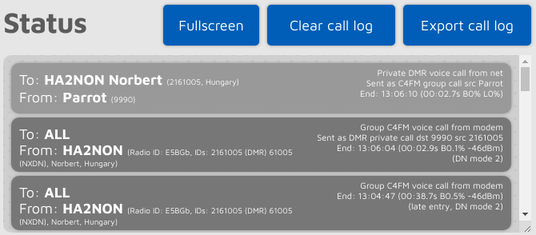Status page
You can see information about the openSPOT2's current status on this page.
Call log

The call log displays all calls coming from the network, from the modem, or from the openSPOT2 itself (voice announcements). In modes where IDs are used as destination and source IDs (ex. DMR, NXDN) the IDs are matched to the ID database and replaced with callsigns. You can get more information about an ID or callsign if you hover the mouse over it.
Each call log entry has information about the call at the top right corner of the entry bubble. BER is displayed in percent after the letter B, packet loss (in case of network calls) is displayed in percent after the letter L. The call duration is also displayed after a call ends.
You can export all call log entries in CSV format by clicking on the Export call log button.
If the Limit call log lines is checked (it's checked by default) then only a limited number of call log entries are allowed to be in the call log. This is good for limiting the web browser CPU/memory use.
Log

The device log is only shown if Advanced mode is enabled.
You can see all device log messages coming from the openSPOT2 here. All log lines are shown here except lines coming from the Wi-Fi module handler. Use the USB serial console log if you also want to see these messages.
If Limit lines is checked (it's checked by default) then only a limited number of log lines are allowed to be in the log. This is good for limiting the web browser CPU/memory use.
You can export the log lines to a .txt file by clicking on the Export log button.
openSPOT2 info

You can see basic information about the device in this section.
The USB data field shows connected when the openSPOT2 is connected to a host with USB enumeration capabilities (like a computer) using a USB cable which supports data transfer, not just charging. The USB serial console can only be used if this field shows connected. The supplied USB cable supports data transfer.
Graphs

The RSSI graph shows receive signal strength from the modem. The BER graph shows received Bit Error Ratio during a call. BER is calculated also for packets received from the network, not just from the modem. The dejitter queue graph (only shown if Advanced mode is enabled) shows the number of packets waiting in the dejitter queue.
About the dejitter queue
All packets received from the network will first go to this queue to eliminate network jitter.
If the dejitter queue length is too short, the graph's line can touch zero during a call and the audio can stop for a moment as the modem runs out of frames to transmit.
If the queue's length is too long, the delay can be uncomfortably high.
You can use this graph to set a proper dejitter queue length. There should be at least a few packets in the dejitter queue when receiving a call from the network. You can set the dejitter queue length on the Network page (the setting only shows up if Advanced mode is enabled). As a general rule, if you have a good network connection to the selected connector's server, set dejitter queue length to 500ms, and if you have a 3G/4G internet connection or voice stutters a lot, try setting the length to at least 1000ms.